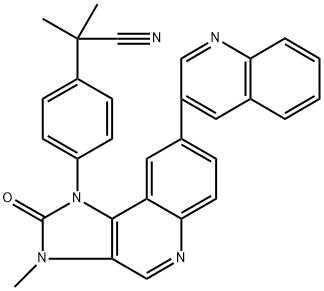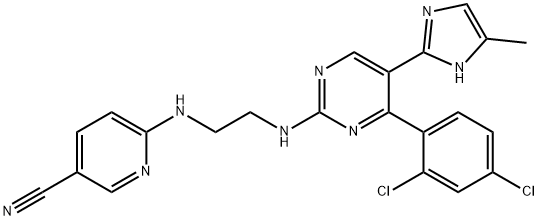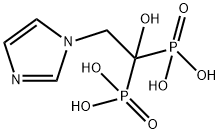Nedaplatin
- CAS NO.:95734-82-0
- Empirical Formula: C2H6N2O3Pt
- Molecular Weight: 301.17
- MDL number: MFCD00866374
- SAFETY DATA SHEET (SDS)
- Update Date: 2025-01-27 09:38:02

What is Nedaplatin?
Toxicity
The toxic effects of nedaplatin are likely similar to those of Cisplatin which produces nausea, vomiting, peripheral neuropathy, and ototoxicity . A major difference between the compounds is the large reduction in nephrotoxicity of nedaplatin compared to Cisplatin .
Description
Nedaplatin, a novel second generation platinum complex, was marketed in Japan for the treatment of a variety of cancers including: head and neck, small-cell and non-small cell lung, oesophageal, prostatic, testicular, ovarian, cervical, bladder, and uterine cancers. Platinum anticancer agents, prototyped by cisplatin, have been reported to be hydrolyzed to the mono- or diaquated species of diamine platinum which react with nucleophilic sites on DNA to cause intrastrand and interstrand crosslinks and DNA-protein crosslinks, which result in cytotoxicity. Nedaplatin was reportedly more active than cisplatin against several solid tumors while sharing less nephro- and gastrointestinal toxicity to cisplatin in viva The minimal renal toxicity displayed by nedaplatin allows its use in patients with deteriorated renal function.
Originator
Shionogi (Japan)
The Uses of Nedaplatin
Nedaplatin is a platinum complex that has potent antineoplatic activity.
The Uses of Nedaplatin
anticancer
Indications
Used in the treatment of non-small cell lung cancer, small cell lung cancer, oesophygeal cancer, and head and neck cancers .
Background
Nedaplatin is a second generation platinum analog . It is less nephrotoxic than Cisplatin but has proven equally effective. It was approved for use in Japan in 1995.
What are the applications of Application
Nedaplatin is a platinum complex that has potent antineoplatic activity
brand name
Aqupla
Pharmaceutical Applications
Nedaplatin, cis-diammineglycolatoplatinum(II), is structurally similar to carboplatin. The chemical structure consists of a central platinum(II) atom with two cis-ammonia groups as nonleaving groups and – in contrast to carboplatin – the dianionic form of glycolic acid as the leaving group. Nedaplatin has been approved for the clinical use in the Japanese market for the treatment of head and neck, testicular, ovarian, lung and cervical cancer. It is typically administered by IV injection and its dose-limiting side effect is myelosuppression.
Pharmacokinetics
Nedaplatin damages DNA and induces cell death in cancer cells . It also functions as a radiosensitizer, increasing the susceptibility of the affected cells to radiation therapy .
Metabolism
Not Available
Properties of Nedaplatin
| storage temp. | Inert atmosphere,Store in freezer, under -20°C |
| solubility | H2O : 13.6 mg/mL (44.86 mM; Need ultrasonic and warming; DMSO can inactivate Nedaplatin's activity)DMF : < 1 mg/mL (insoluble; DMSO can inactivate Nedaplatin's activity) |
| form | Powder |
| color | Light yellow to yellow |
Safety information for Nedaplatin
| Signal word | Warning |
| Pictogram(s) |
 Exclamation Mark Irritant GHS07 |
| GHS Hazard Statements |
H302:Acute toxicity,oral |
| Precautionary Statement Codes |
P280:Wear protective gloves/protective clothing/eye protection/face protection. P305+P351+P338:IF IN EYES: Rinse cautiously with water for several minutes. Remove contact lenses, if present and easy to do. Continuerinsing. |
Computed Descriptors for Nedaplatin
Nedaplatin manufacturer
New Products
3-Iodophenylacetic acid 3-Pyridineacetonitrile, α-hydroxy- 2-Propanamine, 1-chloro-, hydrochloride (9CI) 3-(hexyloxy)-4-(pyridin-3-yl)-1,2,5-thiadiazole 2-Hexyn-1-ol Dibenzo-18-crown-6 Nickel(II) perchlorate hexahydrate, 98% 4-Bromophenylacetonitrile, 95% 3-Bromo-4-fluoroaniline, 97% Sodium tetraborate decahydrate, 98% Palladium(II) acetate, trimer, Pd 99% 4-Bromo-2-chlorotoluene, 97% N N Dimethylformamide Dimethyl Acetal (Dmf Dma) 2,3-Dichloro Benzoyl Cyanide [Side Chain] Bis(2-Chloroethyl) Amine Hydrochloride L-Glutamic Acid Diethyl Ester Hydrochloride 5-(Difluoromethoxy)-2-Mercaptobenzimidazole 1-Ethyl-3-(3-Dimethylaminopropyl)-Carbodiimide Hydrochloride [EDC Hcl] 1,4-Napthoquinone Bromoiodomethane Sodium Bicarbonate Methylene Dichloride (MDC) Ethyl Acetate Indole-3-Carbinol (I3C)Related products of tetrahydrofuran








You may like
-
 Nedaplatin 98.00% CAS 95734-82-0View Details
Nedaplatin 98.00% CAS 95734-82-0View Details
95734-82-0 -
 Nedaplatin CAS 95734-82-0View Details
Nedaplatin CAS 95734-82-0View Details
95734-82-0 -
 17604-74-9 3-Pyridineacetonitrile, α-hydroxy- 98+View Details
17604-74-9 3-Pyridineacetonitrile, α-hydroxy- 98+View Details
17604-74-9 -
 131987-69-4 98+View Details
131987-69-4 98+View Details
131987-69-4 -
 Cyclohexane, (2-propynyloxy)- 67967-07-1 98+View Details
Cyclohexane, (2-propynyloxy)- 67967-07-1 98+View Details
67967-07-1 -
 2-Propanamine, 1-chloro-, hydrochloride (9CI) 98+View Details
2-Propanamine, 1-chloro-, hydrochloride (9CI) 98+View Details
5968-21-8 -
 3-Iodophenylacetic acid 1878-69-9 98+View Details
3-Iodophenylacetic acid 1878-69-9 98+View Details
1878-69-9 -
 132945-75-6 (S)-1-Boc-3-methanesulfonyloxy-pyrrolidine 98+View Details
132945-75-6 (S)-1-Boc-3-methanesulfonyloxy-pyrrolidine 98+View Details
132945-75-6
